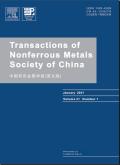Microstructure evolution of K439B Ni-based superalloy casting with varying cross-sections by experiments and simulations
IF 4.7
1区 材料科学
Q1 METALLURGY & METALLURGICAL ENGINEERING
Transactions of Nonferrous Metals Society of China
Pub Date : 2025-04-01
DOI:10.1016/S1003-6326(24)66742-7
引用次数: 0
Abstract
Casting experiments and macro-micro numerical simulations were conducted to examine the microstructure characteristics of K439B nickel-based superalloy casting with varying cross-sections during the gravity investment casting process. Firstly, microstructure analysis was conducted on the casting using scanning electron microscopy (SEM) and electron backscatter diffraction (EBSD). Subsequently, calculation of the phase diagram and differential scanning calorimetry (DSC) tests were conducted to determine the macro-micro simulation parameters of the K439B alloy, and the cellular automaton finite element (CAFE) method was employed to develop macro-micro modeling of K439B nickel-based superalloy casting with varying cross-sections. The experimental results revealed that the ratio of the average grain area increased from the edge to the center of the sections as the ratio of the cross-sectional area increased. The simulation results indicated that the average grain area increased from 0.885 to 0.956 mm2 as the ratio of the cross-sections increased from 6꞉1 to 12꞉1. The experiment and simulation results showed that the grain size became more heterogeneous and the grain shape became more irregular with an increase in the ratio of the cross-sectional area of the casting. CAFE modeling was an effective method to simulate the microstructure evolution of the K439B alloy and ensure the accuracy of the simulation.
通过实验和模拟研究不同截面 K439B 镍基超级合金铸件的显微组织演变
通过铸造试验和宏观微观数值模拟,研究了不同截面的K439B镍基高温合金铸件在重力熔模铸造过程中的组织特征。首先,利用扫描电镜(SEM)和电子背散射衍射(EBSD)对铸件进行了显微组织分析。随后,通过相图计算和差示扫描量热(DSC)试验确定了K439B合金的宏观微观模拟参数,并采用元胞自动机有限元(CAFE)方法对不同截面的K439B镍基高温合金铸件进行了宏观微观建模。实验结果表明,随着横截面积比的增大,平均晶粒面积比从边缘向中心增大。模拟结果表明,随着横截面比从6 1增加到12 1,平均晶粒面积从0.885增加到0.956 mm2。实验和模拟结果表明,随着铸件横截面积比的增大,晶粒尺寸变得更加不均匀,晶粒形状变得更加不规则。CAFE建模是模拟K439B合金微观组织演变并保证模拟精度的有效方法。
本文章由计算机程序翻译,如有差异,请以英文原文为准。
求助全文
约1分钟内获得全文
求助全文
来源期刊
CiteScore
7.40
自引率
17.80%
发文量
8456
审稿时长
3.6 months
期刊介绍:
The Transactions of Nonferrous Metals Society of China (Trans. Nonferrous Met. Soc. China), founded in 1991 and sponsored by The Nonferrous Metals Society of China, is published monthly now and mainly contains reports of original research which reflect the new progresses in the field of nonferrous metals science and technology, including mineral processing, extraction metallurgy, metallic materials and heat treatments, metal working, physical metallurgy, powder metallurgy, with the emphasis on fundamental science. It is the unique preeminent publication in English for scientists, engineers, under/post-graduates on the field of nonferrous metals industry. This journal is covered by many famous abstract/index systems and databases such as SCI Expanded, Ei Compendex Plus, INSPEC, CA, METADEX, AJ and JICST.

 求助内容:
求助内容: 应助结果提醒方式:
应助结果提醒方式:


